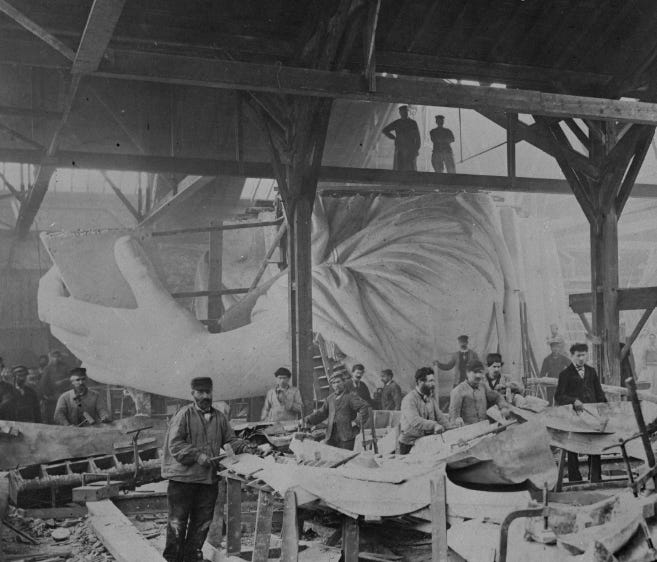
Happy anniversary to our greatest arrival, Lady Liberty. I can’t help myself, it looks like she’s checking her phone.
Ukraine
Lithuania pledges an additional 1Bn Euros for Ukraine’s defense. Meanwhile, Ukraine has played the purchase card with President Trump, offering a shopping list to Secretary Bessent last week.
The Life Strategy in operation - helicopters aid the firefighting in Kyiv on Monday in the wake of yet more Russian terror bombing. I remain committed to the proposition that the best way to expand support to Ukraine is to displace the Life Strategy logistics of civilian support materiel to a defiant air campaign. Berlin Airlift Putin into the ground.
Strikes against Russian industrial capacity continue. The Nevinnomyssky Azot fertilizer plant in Stavropol Krai, one of the top producers of ammonia and nitrogen fertilizers in the country, halted production after drone attacks. Another attack was charted in Orenberg, 1500km from Ukraine, and likely home to strategic missile base. In an effort to blunt the drone campaign, authorities cut mobile services to vast swathes of Russian territory. It ends up being a map of strategic priorities. Oops.
Defense
Coordinating procurement, Slovenia will join Bulgaria, Portugal, Croatia, Estonia, and France in a combined purchase of the French Caesar self propelled howitzer. “Joint procurement enables participating countries to reduce costs through bulk orders and accelerate delivery timelines by providing manufacturers with predictable production volumes.”
Military Mobility consultation in Europe launched. The Centre for Security, Diplomacy, and Strategy (CSDS) in Brussels has published its own perspective. On rail and national security, this Dutch military perspective highlights the role played by rail resilience in Ukraine and its future importance to NATO.
The debate about technological adaptation in defense is evergreen, the fear of not adequately keeping pace a perennial issue to policymakers. In reality, technological leadership, especially outside of war, is an equivocal advantage. It still remains for policy and strategy to apply it correctly. (Or not at all.) The Ukraine battlefields are a temptation to current planners as an image of the future. But even as the present is being written in this war, its future edition is facing heavy edits. Making significant commitments to capabilities that are today effective is costly in both opportunity and sunk costs. Until the next field of combat is set, path defining investments should be avoided.
“The more things change…” Rail officers in the 19th and 20th centuries give way - today’s lateral recruitment is from the tech sector, as the Army brings in four new Lieutenant Colonels from the private sector.
Closing on the politics of budgets, with the NATO meeting this week, members have agreed the 5% target, to be reached by 2035. While some states (such as those on Russia’s frontiers) have advanced their budget amounts for good reason, whether a wholesale large spend is wise is highly contested. It is clear the agreement is more about the diplomacy of maintaining President Trump’s support for the organization.
Iran Strikes
As tensions in the region mounts, maritime watchers are glued to the traffic in the Straits of Hormuz for signs that Iran has impeded passage. Despite concerns, the waters remain open through the start of this week, despite US strikes and continuing Israeli bombing. Recall here pieces on American grand strategy and maritime chokepoints and their importance to modern society.
Early OSINT indications of President Trump’s participation in Israel’s campaign against Iran came last Monday from the logistical preparation, as the tanker fleet for mid-air refueling were put in motion in the US and Europe. (For example, here, the aviation data reflects the aircraft that took of for European bases.)
For broader monitoring of the Israeli strikes, INSS has the map.
Maersk pauses calls to the port at Haifa amid heightened risk concerns while the strikes between Israel and Iran are ongoing. Electronic warfare may also have impacted maritime navigation in the region. The vulnerability of the many networked and digital systems needs addressing - and the maintenance of “low tech” skills and capabilities should be a significant priority.
The Trump Administration targeted nuclear development sites, indicating, at least in some part (despite regime change rhetoric) limitations upon the force the US was willing to use. Further, the strikes were accompanied by notification to Iranian authorities, to avoid escalatory uncertainty.
And in infrastructure risk, critical networks across the US running water, power, transport, and other systems are at heightened alert for Iranian cyberattacks. Post-DOGE, it is worth asking whether the Federal Government retains the necessary capabilities and capacities necessary to defend the nation’s digital and other infrastructure. Furthermore, what law enforcement capacity in cyber has been seconded to the immigration crackdown? Have the President’s policies left gaps of vulnerability as yet unidentified?
Trade
Bloomberg reports exporters are turning on the dollar as a currency to take and hold. Among the problems with the US economy that this indicates, it is yet another boost to the cost of doing business in trade.
At the G7-1, on negotiations over tariffs with the US, and President Trump’s claims that the Canadian pitch was “complex,” Prime Minister Carney responded, “The complexity is often in the eye of the beholder.”
Infrastructure
The Spanish power outage was caused by “grid operator REE's failure to calculate the correct mix of energy was one of the factors hindering the grid's ability to cope with a surge in voltage that led to the massive blackout across Spain and Portugal on April 28, a government investigation concluded.”
Climate change will cost more than expected, while that of mitigation is shrinking. This as Federal Reserve Chair Powell gave grim news on mortgages and regions of risk:
USDOT Secretary Duffy threatens transportation funds over immigration policy disputes between Federal, State, and Local authorities regarding the operation of ICE. And despite the Federal Government’s opposition to the policy, Congestion Pricing is paying off for everyone, including drivers, with less time reported being wasted in traffic, saving thousands of hours in the aggregate. This will also have implications for commerce, as deliveries can be made with more efficiency.
All forms of mass or popular transportation need regulation, even cycling. Clapham Common and the scourge of bike traffic in relative anarchy.
Big economic moves are difficult, no more so in managing the financing of large, uncertain projects. (AI being the outlier.) In this report is discussed how formats of public procurement can establish new manufacturing capacity in the area of electric school buses.
And now, there is a game that simulates the development and construction of a major urban infrastructure: “Cross Bronx Expressway is the third game in the Irregular Conflicts Series. It simulates the socio-economic processes of urban development, and the human costs that result, as a competitive city-builder with collective loss conditions. Players control one of three asymmetric factions working in the South Bronx between 1940 and 2000, pursuing their own goals while cooperating to keep the borough viable. Through a card driven sequence of play, they will work to solve the economic challenges facing the area by building infrastructure and organizations, forming coalitions, mitigating the multitude of issues facing the vulnerable population, and managing resources to stay out of debt. Cross Bronx Expressway offers an engaging way to learn about the recent history of American cities, as exemplified by Jane Jacobs' pivotal work The Death and Life of Great American Cities, simulated through the case study of the South Bronx. Players will experience the conflicting incentives and complex factors shaping urban life and together determine the fate of the Bronx.”
Data
Everything in the modern data world is hungry for resources. Power, supply chain inputs, information and content, water, and so on. In the UK, there is concern about the ability to plan for water needs in a system where data centres do not report usage. Are we doing all of this for a machine that may navigate hikers off a cliff, but will rot our brains with extended use? MIT research findings are concerning - but in an act of cheek, the text of the report were mined with AI traps. We are through some kind of looking glass.
Agriculture
ICE raids are hitting farm labor in the Rio Grande Valley as workers - both legal and undocumented - are simply refusing to show up. Although President Trump promised exclusions for certain sectors given their critical reliance upon migrant labor, this has not been reflected in operations.








